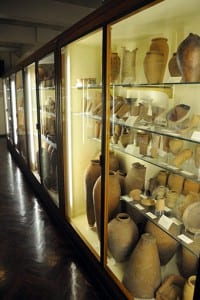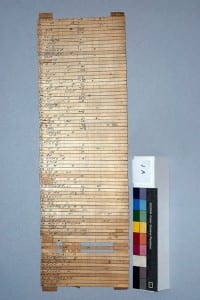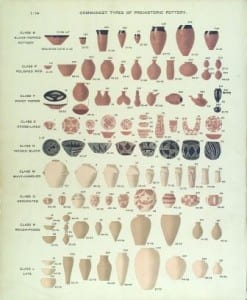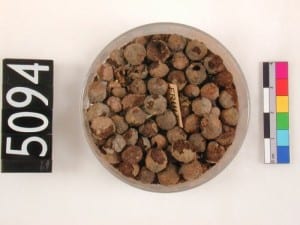Making time for Predynastic Egypt
By Debbie J Challis, on 5 September 2013
Written by Alice Stevenson
Flinders Petrie was good with numbers. He liked nothing better than to measure, calculate and plan. These were the skills that allowed Petrie in 1899 to create the first detailed timeline for the period just before the First Dynasty of Egypt.
He did this by comparing assemblages of hundreds of Predynastic pottery vessels unearthed by his teams in prehistoric cemeteries of Upper Egypt. Many of these beautiful pots are on display in the Petrie Museum. The Petrie Museum also holds in its archives his Sequence Dating slips, each of which records the different types of pottery that were found in individual tombs.
Using the codes for pottery noted on these thin strips of card he noticed things like different types of decorated pottery that were never found together in the same tomb and separated these graves into two groups. Another key assumption was that wavy handled vessels changed over time from globular to cylindrical, with the handle ‘degenerating’ to a simple line under the rim.
By continuing to group together pottery types, grouping like with like and separating out dissimilar forms Petrie sorted 900 slips into an order. He called it sequence dating. Petrie’s method is now known to archaeologists as a type of seriation, a complex statistical procedure for which we usually use computers! Petrie had managed to do it all on paper. Mathematicians are also impressed and it was the first instance of mathematical modelling in archaeology.
Petrie’s Sequence Dating was a great achievement in what is known as relative dating. This type of chronological work puts things into an order – a sequence – but it does not actually measure time. There is no way of knowing how many years have passed between the use of one pottery vessel and the introduction of a new type. All relative dating tells us is what is earlier and what is later.
More than a century later mathematical modelling is again being used to create a timeline for early Egypt . This time the focus has been radiocarbon dating, which is a technique that can measure time and give a date in years. It is a method of absolute dating. Once again Petrie’s pots and the other finds his Egyptian workforce uncovered are the primary data for cutting edge study.
Several organic samples of basketry and plant remains from the Petrie Museum were used in this new study demonstrating how valuable such collections are for modern scientific studies.
To see a podcast from the Petrie Museum filmed by the Royal Society please click here.
Written by Alice Stevenson, Curator of the Petrie Museum of Egyptian Archaeology
Cited article: Michael Dee, David Wengrow, Andrew Shortland, Alice Stevenson, Fiona Brock, Linus Girdland Flink, and Christopher Bronk Ramsey (2013),
An absolute chronology for early Egypt using radiocarbon dating and Bayesian statistical modelling, Proc R Soc A 2013 469: 20130395
3 Responses to “Making time for Predynastic Egypt”
- 1
-
2
Flinders Petrie, Father of Archaeology – Stories from the Museum Floor wrote on 17 June 2016:

[…] for detail, and love for calculations allowed him to formulate a relative chronology, and create a timeline for prehistoric Egypt, through the formulation of a relative chronology using ceramics found at Naqada in the 1894-5 […]
-
3
Predynastic dating, a potter’s method is an archaeologist’s key | Egypt and Eternity wrote on 25 April 2017:

[…] Paper sequences made and used by Petrie UCL Blog: Making time for Predynastic Eypt […]
 Close
Close






[…] Petrie’s Series Dating. Available from: blogs.ucl.ac.uk […]